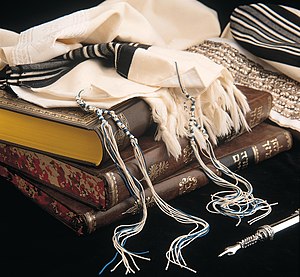This article has multiple issues. Please help improve it or discuss these issues on the talk page. (Learn how and when to remove these messages)
|



| Part of a series on |
| Jews and Judaism |
|---|
Tekhelet (Hebrew: תְּכֵלֶת təḵēleṯ; alternative spellings include tekheleth, t'chelet, techelet, and techeiles) is a highly valued dye described as either "sky blue" (Hebrew: תּכוֹל, romanized: tāk̲ol, lit. 'azure'),[1][2] or "light blue" (Hebrew: כחול בהיר, romanized: kāḥol bāhîr, lit. 'light 'navy blue'', see Arabic kohl),[3] that held great significance in ancient Mediterranean civilizations. In the Hebrew Bible and Jewish tradition, tekhelet was used to colour the clothing of the High Priest of Israel, the tapestries in the Tabernacle, and the tzitzit (fringes) attached to the corners of four-cornered garments, including the tallit.[4]
The Bible does not specify the source or production method of tekhelet. According to later rabbinic literature, it was exclusively derived from a marine creature known as the ḥillāzon (חלזון, from Ancient Greek: ἑλικών, romanized: helikṓn).[a] However, the knowledge of tekhelet production was lost during the Middle Ages, leading to the omission of tekhelet from tzitzit. In recent times, many Jews believe that experts have identified the Ḥillazon and rediscovered the process for manufacturing tekhelet, leading to the revival of its use in tzitzit. The snail Hexaplex trunculus (historically known as Murex trunculus) is widely considered to be the creature responsible for producing authentic tekhelet.
A garment with tzitzit consists of four tassels, each containing four strings. There are three differing opinions in rabbinic literature regarding the number of strings that should be dyed with tekhelet: two strings,[6] one string,[7] or one-half string.[8]
- ^ "Techelet (Skyblue Thread)". Tzitzit and Tallis. Chabad Media Center. Retrieved 9 April 2013.
- ^ Chaim Miller, ed. (2006). Chumash: the five books of Moses: with Rashi's commentary Targum Onkelos and Haftaros with a commentary anthologized from classic rabbinic texts and the works of the Lubavitcher Rebge (Synagogue ed.). New York, N.Y.: Kol Menachem. p. 967. ISBN 9781934152010.
- ^ Everett Fox, The Five Books of Moses: A New Translation with Introductions, Commentary, and Notes. New York: Schocken Books, 1995.
- ^ Zohar, Gil. "Fringe Benefits – Kfar Adumim factory revives the lost commandment of tekhelet". ou.org. Retrieved 14 March 2013.
- ^ "Tosefta Menachot 9:6". www.sefaria.org.
- ^ Rashi, Tosafot, Asher ben Jehiel
- ^ Raavad
- ^ Rambam
Cite error: There are <ref group=lower-alpha> tags or {{efn}} templates on this page, but the references will not show without a {{reflist|group=lower-alpha}} template or {{notelist}} template (see the help page).